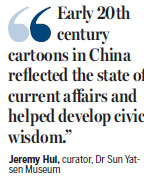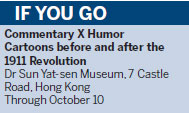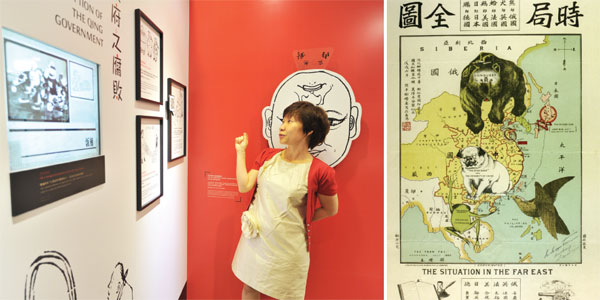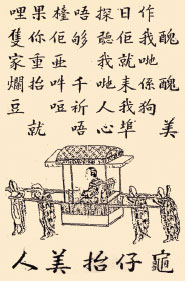Cartoon call
Updated: 2016-07-01 07:46
(HK Edition)
|
|||||||||
Early 20th-century Chinese cartoons could even influence political decisions at the highest level. A selection of these are now showing at HK's Dr Sun Yat-sen Museum.
Sun Yat-sen, the founding father of the Republic of China, was born on Nov 12, 1866. To commemorate the 150th year of his birth, and also the 105th year of the end of dynastic rule in China - the result of a movement in which Sun played a leading role - an exhibition of cartoons throwing light on this era is now on in the city.
In some of the cartoons drawn in the years leading up to the people's uprising, artists have tried to look at China in the context of the political situations across the world. Tse Tsan-tai, a revolutionary, journalist and author, published a political cartoon titled The Situation in the Far East in Newsletter of Foo Yan Man Ser in 1898-99. In it, a bear, a bulldog, a frog, an eagle, the sun, and a sausage represent Russia, Britain, France, the US, Japan, and Germany, respectively. The Russian bear looms large over the map of China, suggesting it's the biggest threat to the country. It is also out to conquer Manchuria, Mongolia, and Korea, trying to subdue these cultures and exert hegemonic control. The British bulldog, it is suggested, favors an "Open Door" policy for China, with a view to accessing its market. It is also keen to retain the "territorial integrity of China", stop other world powers from establishing exclusive colonies in Chinese land. The American eagle has the motto "blood is thicker than water" strung around its neck. This is from a comment made by the American Admiral Josiah Tattnal in 1859 when he broke away from the neutral position held by America and gave logistical support to England during the Second Opium War. It suggests that the US will side with John Bull in its China policy.

Since most Chinese were ignorant of global politics at the time and would not have readily recognized the symbolism and the allusions to political affairs, Tse added captions for their better understanding.
The curator of Dr Sun Yat-sen Museum, Jeremy Hui, feels Tse was the forerunner of Chinese political cartoons. It was a style cartographers would later borrow when they drew historical maps of China. Tse wrote in an article, The Chinese Republic: Secret History of the Revolution, in South China Morning Post in 1924 that he allowed fellow revolutionary Yeung Ku-wan, with whom he had founded the Furen Literary Society, to publish an exaggerated version of the same cartoon in color, which led Hong Kong's colonial secretary to question Tse's political position. The original cartoon was reprinted by Cai Yuanpei in Alarming Russian News in 1903. Cai called the image, Dividing Up China Like a Melon, and commented that the image "would raise even a 6 or 7-year-old kid's indignation".
Far-reaching impact
In addition to disseminating information and generating awareness, some political cartoons had major social impact. Turtles Carrying a Beauty in a Sedan Chair, drawn by Pan Dawei, was one such. Pan, a member of the Chinese Revolutionary Alliance, drew the image in 1905, in the wake of the anti-American boycott observed to protest against the US Congress' law restricting Chinese laborers from entering the US. The sketch is a caricature of a US delegation visiting Guangzhou to negotiate a new immigration treaty between the Chinese and American governments, led by secretary of war, William Howard Taft, and Alice, the daughter of American president Theodore Roosevelt.
In the cartoon, four turtles carry a woman, an allusion to Alice Roosevelt, in the sedan chair. The cartoon implies that whoever carries the sedan chair for Americans is as low as a turtle. Pan posted such cartoons along the road from Tianzi Wharf to the local government office in Guangzhou overnight, so that sedan chair carriers might be persuaded to refuse carting Americans.

Curator Hui believes Pan's cartoon did have an impact on the boycott movement. "The British colonial government in Hong Kong felt the pressure and deported Li Daxing, who had published Pan's cartoon in a Hong Kong newspaper," Hui said. "The cartoon mattered to the colonial government because it might potentially endanger US-British relations."
The image also featured lines Pan wrote for a naamyam (a traditional Cantonese performance form involving songs with a narrative) number. It went like this: "The American beauty treats us like dogs. She wants to know if we are united."
"Early 20th century cartoons in China reflected the state of current affairs and helped develop civic wisdom," says Hui.
Dara Wang contributed to the story.
|
Left to right: Curator of Dr Sun Yat-sen Museum Jeremy Hui describes the finer points of a cartoon at the Commentary X Humor show. The Situation in the Far East, published around 1899, spawned several variations on the theme in subsequent years. Photos provided to China Daily |
|
Turtles Carrying a Beauty in a Sedan Chair, published in 1905, satirized the US delegation to Guangzhou to negotiate a new immigration treaty in the wake of the anti-American boycott. |
|
The exhibition of cartoons marks Sun Yat-sen's 150th birth anniversary as well as the 105th year of the Xinhai Revolution. |
(HK Edition 07/01/2016 page8)


